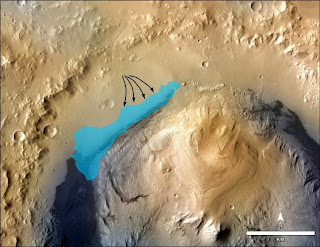NASA rover discovers ancient fresh water lake on Mars..
Scientists have found evidence of an ancient freshwater lake on Mars well suited to support microbial life, the researchers said Monday. The lake, located inside Gale Crater where the rover landed in August 2012, likely covered an area 31 miles (50 km) long and 3 miles (5 km) wide, though its size varied over time.
Analysis of sedimentary deposits gathered by NASA's Mars rover Curiosity shows the lake existed for at least tens of thousands of years, and possibly longer, geologist John Grotzinger, with the California Institute of Technology in Pasadena, told reporters at the American Geophysical Union conference in San Francisco. "We've come to appreciate that is a habitable system of environments that includes the lake, the associated streams and, at times when the lake was dry, the groundwater," he said.
Analysis of clays drilled out from two rock samples in the area known as Yellowknife Bay show the freshwater lake existed at a time when other parts of Mars were dried up or dotted with shallow, acidic, salty pools ill-suited for life. In contrast, the lake in Gale Crater could have supported a simple class of rock-eating microbes, known as chemolithoautotrophs, which on Earth are commonly found in caves and hydrothermal vents on the ocean floor, Grotzinger said. Scientists also reported that the clays, which form in the presence of water, were younger than expected, a finding that expands the window of time for when Mars may have been suited for life.
 |
| This illustration depicts a concept for the possible extent of an ancient lake inside Gale Crater. Image Credit: NASA |
Previous studies from Mars orbiters, landers and rovers have provided increasing evidence for a warmer, wetter, more Earth-like Mars in the planet's past. Ancient rocks bear telltale chemical fingerprints of past interactions with water. The planet's surface is riddled with geologic features carved by water, such as channels, dried up riverbeds, lake deltas and other sedimentary deposits. New related studies on how much radiation blasts the planet set new boundaries for how long any organic carbon, which so far has not been found on Mars, could have been preserved inside rocks within about 2 inches (5 cm) of the surface, the depth of Curiosity's drill. But finding rock samples with relatively short exposure times should not be a problem.
An age-dating technique, used for the first time on Mars, reveals that winds are sand-blasting away the rock faces at Gale Crater. One of the mudstones at Yellowknife Bay, for example, has been exposed to the destructive effects of cosmic rays for only about 70 million years, well within the period of time to detect organics, said Don Hassler with the Southwest Research Institute in Boulder, Colorado.
The Yellowknife Bay samples also showed hints of possible organics that may have been destroyed in the rover's laboratory oven due to highly oxidizing chemicals known as perchlorates, which so far seem to be ubiquitous in the Martian soil. Scientists will continue to look for rocks that may have higher concentrations of organics or better chemical conditions for their preservation, Grotzinger said.
"A key hurdle that we need to overcome is understanding how those organics may have been preserved over time, from the time they entered the rock to the time that we actually detect them," said Curiosity scientist Jennifer Eigenbrode with NASA's Goddard Space Flight Center in Greenbelt, Maryland.
Curiosity currently is en route to a three-mile high (5 km) mound of layered rock rising form the floor of Gale Crater, a formation known as Mount Sharp. Based on the new information gleaned from the Yellowknife Bay samples, scientists are developing a new strategy to look for organics there. Even if life never started on Mars, organic material presumably would have been deposited on the surface by crashing comets and asteroids.
Read more at http://www.dnaindia.com/scitech/report-nasa-mars-rover-finds-evidence-of-life-friendly-ancient-lake-1932467


















0 comments:
Post a Comment